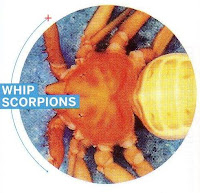Humans have
made their way to the moon, landed rovers on Mars and sent spacecraft to the
outer reaches of the solar system. But the Earth remains a little-known planet.
That becomes clear when naturalists look for creatures closer to home and find
unknown gems. Here are our favorite new species of 2016.
UNKNOWN
TUMBLER
Tumbleweeds
are synonymous with the American West. At some point, two of them interbred to
form a new species, Salsola ryanii,
which is about 5 feet
in height and nearly as wide. Usually, such hybrids are sterile, but in this
case, the plant underwent an unusual genetic event that led to a duplication of
its entire genome. That allowed it to reproduce and also made it incompatible
with either of its parents. It has been found at 15 sites throughout
California. "It's extremely rare to catch a new species in the act of
appearing and expanding," says Norm Ellstrand, a professor of genetics at
the University of California, Riverside, "and very exciting."
When
biologist Jean Krejca unearthed an extremely leggy millipede in a remote cave
in California's Sequoia National Park, she knew it was special, so she sent it
to the millipede experts Bill Shear and Paul Marek. They determined it was a
new species and gave it the name Illacme Tobini. With 414
legs, it's one of Earth's leggiest creatures. It is closely related to Illacme plenipes, which lives about 150 miles away and has
750 legs—the most of any animal. The millipede also has four gonopods, the
millipede equivalents of penises, and boasts zoo poison glands.
A
VEGETARIAN PIRANHA
Piranhas
are famous for their fearsome teeth and ability to quickly devour flesh. But
not all creatures in this biological family are so brashly carnivorous.
Researchers from Brazil's Federal University of Para have discovered a new species
of piranha-like fish with chompers specialized for grinding seeds and other
vegetable debris that falls into the tributaries of the western Amazon, where
it lives. It grows to a length of i8 inches and has reddish coloration, with
yellow on its fins and belly, and it is sought after by fishermen for its meat.
The biologists named it Myloplus Zorroi, after
the fictional character Zorro, a hero in Latin America.
WHIP SCORPIONS
Whip
spiders, also known as tailless Whip Scorpions, display
more variety than scientists knew. Brazilian researchers uncovered eight new
species of these animals in the Amazon rain forest of northern Brazil. They
aren't true spiders—they lack silk and venom glands—but they do possess
fearsome-looking appendages called pedipalps that look like arms with claws and
are used to grab prey. These spiny freaks hang out in caves or leaf litter. To
tell the species apart, researchers Gustavo Miranda and Alessandro Giupponi
counted the hairs on their pedipalps.
THE LEAF
THAT WASN'T
When is a
leaf not a leaf? When it's a spider. Max Kuntner, an arachnologist at the
Research Center of the Slovenian Academy of Science and Arts, and colleagues
discovered the creature on a night-time walk through a rain forest in southern
China. They placed it in the genus Poltys with orb-weaving
spiders that live in China and produce distinctive circular webs. It's the
first arachnid known to mimic foliage, a survival strategy that helps it avoid
predation by wasps and other insects.
SNAKE IN
THE SUN
The Bahamas
are hardly an unexplored place. It came as quite a shock, then, to
herpetologist Graham Reynolds when he found a handsome, undescribed silver
serpent on a small uninhabited Bahaman island. Reynolds, who works at the
University of North Carolina-Asheville, called it the Conception Bank silver
boa (Chilabothrus Argentum), and it's already listed as
critically endangered: Reynolds and his colleagues found only 33 of them on the
island.
GLOWFISH
These fish
don't need a light—they carry their own, thanks. In August, scientists reported
that they had found two new species of deep sea fish with this unusual
arrangement. They have light-producing bacteria in a pouch within their gut
that makes them appear to glow. They can change the size of this pouch,
contracting it to hide the light and expanding it to reveal the light, which
then passes through transparent scales on their underside. The scientists
dubbed these new species the gray mirrorbelly and black mirrorbelly—Monacoa Griseus and Monacoa
niger.
PARASITE IN
PURPLE
While most
plants rely on the sun for energy and food, some pursue an alternative
stratagem: thievery. Japanese scientists have found a bizarre new plant they
call Sciaphila yakushimensis (after
Yakushima, the lush Japanese island where it was found). This species, like its
relatives, makes its way aboveground only when it flowers—in this case with a
purple blossom. It gets its sustenance by stealing nutrients from the roots and
root-bound fungi of other plants.
JOHNNY'S
FAVORITE CRAWLER
How many
kinds of tarantulas exist in the United States? Until evolutionary biologist
Chris Hamilton investigated, nobody knew. He and his colleagues spent nearly a
decade looking for tarantulas and sorting through contradictory past studies.
The team turned up 14 new tarantula species, mostly in the Southwest. An
all-black species found near California's Folsom Prison—where Johnny Cash, the
Man in Black, recorded a live album—was dubbed Aphonopelma johnnycashi.
TEENY-TINY
PEACOCKS
Australian
biologist Jurgen Otto has spent the past decade cataloguing Peacock Spiders, the males of which engage in adorably
strange jigs to woo females, extending their furry legs and flashy abdomens.
He's discovered dozens of new varieties, and in May, he co-authored a paper in
the journal Peckhamia identifying
seven more. The spiders range in length from 0.1 to 0.2 inches , and they are
often brightly and brilliantly colored.
Source:
Newsweek, 6.01.2017 – 13.01.2017, by Douglas Main, pp. 52–53.








No comments:
Post a Comment